Egyptian Koshari is the ultimate comfort food. Carbs upon carbs of delicious, made with layers of chickpeas, rice, vermicelli, pasta, a spiced tomato sauce (as well as dukka, a second sauce made using cumin!), and fried onions. This is Egypt’s national dish for good reason!
I’m ashamed to say that the very first time I tried Egypt’s favourite street food, Koshari (often spelled, koshary or kushari), I was already in my thirties. Despite having ample opportunity to try the national dish of Egypt, I never paid much attention to it. The joke was on me because this Egyptian recipe is positively delicious!
Jump to:
What is Koshari
If you’ve not been fortunate enough to be exposed to koshari, brace yourself! This Egyptian recipe is a carb-heavy delight. It’s made from layers of rice, chickpeas, pasta, vermicelli, and fried onions; topped with two sauces, the first is a spiced tomato sauce, the second is dukka – or daqqa – a garlic and cumin-based sauce that adds a wonderful brightness to the recipe.
What’s interesting about koshari is that it’s not a dish designated to any specific meal – during my time in Egypt, I learned that it’s a popular as a lunch, dinner, or snack! It’s also one of the few dishes where it’s often acceptable to return to the vendor to ask for a few more spoons, or a “kemela”!
What is the origin of koshari
There are a few different speculations to the origins of Egyptian koshari. The most popular is that koshary originated in ancient Egypt as kosheir, meaning “The food of the Gods”.
Another popular take is that Egyptian koshary is a variation of the Indian dish, khichri, which was brought over from India to Egypt by the British (during their period of colonization).
Historians have speculated that Italians living in Egypt added pasta (typically, ditalini pasta or macaroni) to khichri, while local Egyptians finished the dish as we know it by adding the delicious dukka as well as some of the other ingredients.
The dish also resembles mujadara, another popular Middle Eastern dish. As such, some have speculated that koshari is a variation on mujadara.
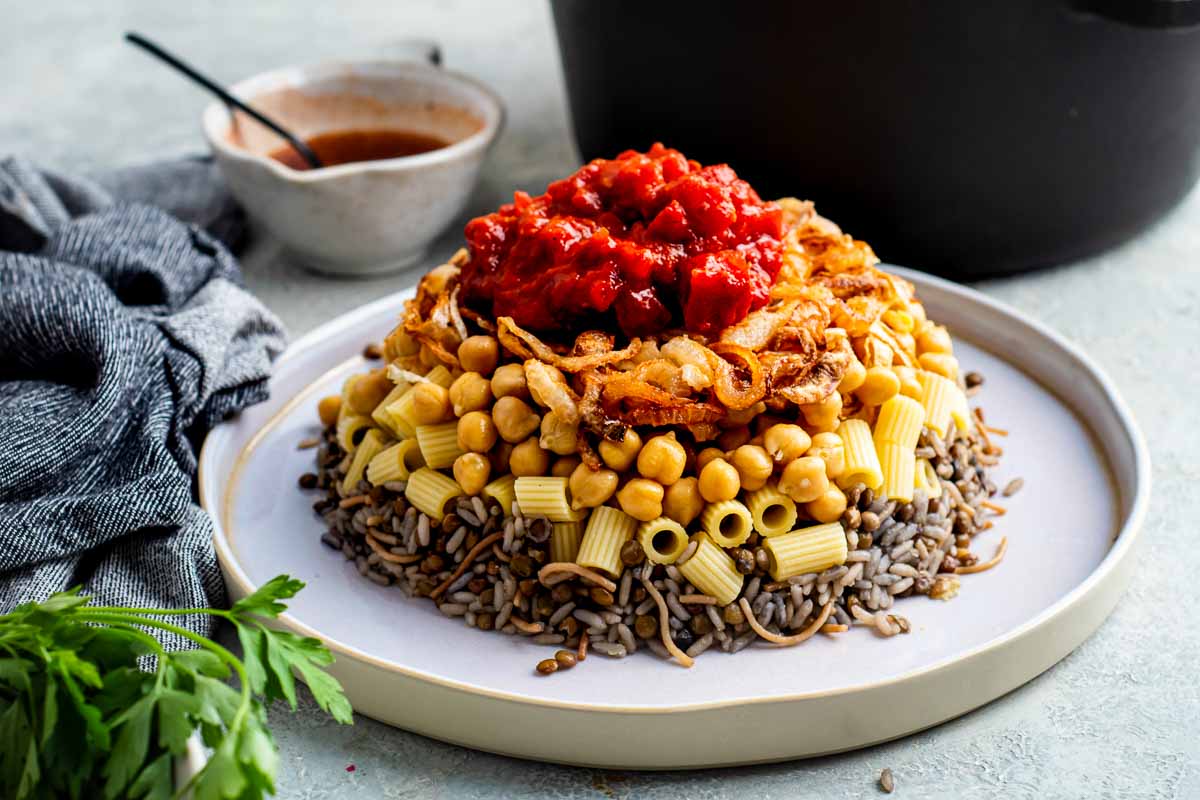
Ingredients
Given that a koshari recipe is actually a few different recipes compiled together, there is a long list of ingredients below. Don’t worry! Once you come to the recipe instructions, you’ll see that while there are a few different components (and pans!) involved, the recipe is actually quite simple.
- Chickpeas rinsed and drained
- Ditalini pasta
Fried Onions
- Onions, sliced thin into rings
- Salt
- Cornstarch
- Vegetable oil
Tomato Sauce
- Fried onions
- Reserved vegetable oil
- Garlic cloves
- Tomato paste
- Tomato sauce
- Water
- Salt and pepper
- White vinegar
- Paprika
Lentil Rice
- Reserved oil
- Fried onions
- Brown lentils, rinsed and drained
- Rice, rinsed and drained
- Vermicelli, toasted
- Water
- Hot water
- Ground cumin
Dukka / Cumin Sauce
- White vinegar
- Garlic, crushed
- Hot water
- Ground cumin
- Salt, to taste
- Ground black pepper
- Paprika
How to make Egyptian Koshari
Making koshary at home can be a little daunting – there are just so many components to it! Beyond the pasta, there’s the dukka, the fried onions, the lentil rice, and the tomato sauce (that’s made with a mix of spices).
Of course, if you’re feeling a little constricted for time (and/or effort), you may be able to pick up one or more of the components from your local Middle Eastern grocery store! However, assuming you’re starting from scratch, there are two main steps you’ll need to get through:
- Cooking and preparing the various components
- Assembling your components to make koshari
Fried Onions for Koshari
Super simple to do – you’re going to toss your sliced onions with cornstarch and salt, deep fry them in oil (vegetable, canola, or sunflower oil is great for this), and then set aside the fried onions to dry on a paper towel. Set aside the oil used for cooking the onions, as you’ll be using it again to make the tomato sauce.
Spiced Tomato Sauce
Heat some of the oil you set aside earlier with garlic over medium heat in a saucepan or small pot. Be careful not to burn your garlic (I crush mine, but minced garlic works too!), this is just the first step. Next, add the remaining ingredients, bring to a boil, reduce your heat to medium low, cover, and allow to simmer for fifteen minutes.
Koshari Rice (with Lentils)
In a heavy-bottomed pot over medium-high heat, add the remaining reserved oil and fried onions (you can set some aside to use as a topping), lentils, alongside a tablespoon of salt (because seasoning is good). Stir, add four cups of water and bring to boil, maintaining for ten to fifteen minutes (or until your lentils have cooked through).
Without draining, stir in rice, vermicelli, two cups of hot water, one more tablespoon or salt (because, seasoning!) and ground cumin. Bring the mixture to boil, reduce heat and simmer for twelve to fifteen minutes (or until the pasta is cooked). Fluff with a spoon or fork.
Cumin Sauce (Egyptian Dukkah)
Mix all the ingredients together. Easy peasy!
How to assemble the perfect koshari bowl
The koshary assembly order is almost as important as the preparation of its various components. Thankfully, this a very easy process (and honestly, not a big deal if you mess it up – it’s quite common for people to mix their koshari as they eat).
- Lentil rice goes at the bottom, forming the base.
- The cooked pasta is layer number two.
- Chickpeas
- Fried onions
- Spiced tomato sauce
- Drizzle on the dukkah (the cumin-based sauce)!
If you like what I’m doing here, and you want to help, why not go ahead and become a Patron? You can support Chocolates & Chai for as little as the price of a cup of coffee!
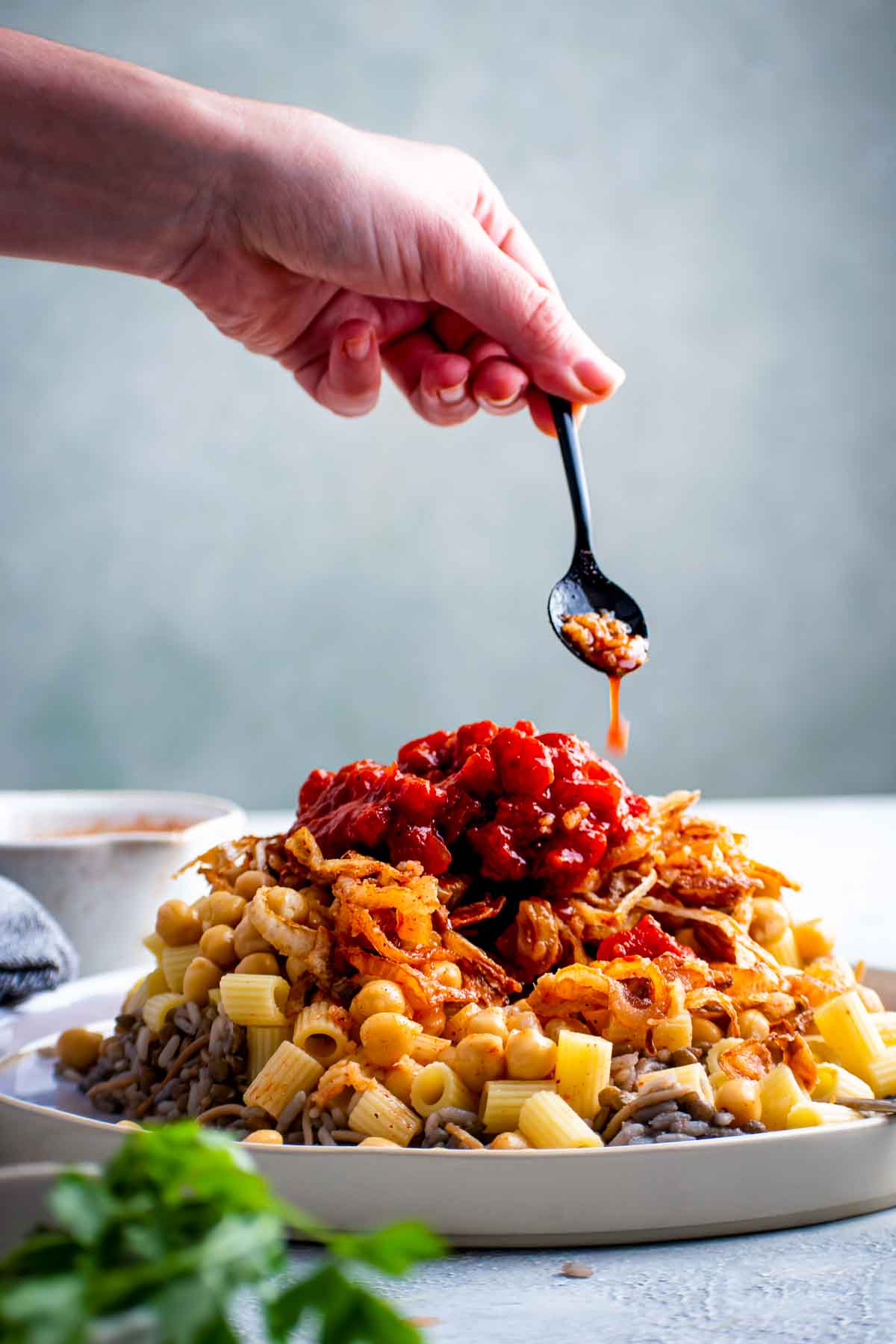
Variation suggestions
Some variations for making koshari include:
- Experimenting with different types of pasta, such as spaghetti or fusilli, in place of the ditalini (or macaroni).
- Adding vegetables such as diced tomatoes, bell peppers, or eggplant to the tomato sauce for extra flavor and heartiness.
- Substituting quinoa or bulgur for the rice to create a gluten-free option.
- Using a mix of different lentils for added texture.
- Making the dish spicier by adding more red pepper flakes and ground cumin to the tomato sauce.
- Topping the dish with a fried egg, chickpeas, or crumbled feta cheese for added protein, and a little flavour variation.
- Serving the dish with a side of tahini sauce or yogurt to cool the palate and balance out the spices.
Keep in mind that variations, while delicious, do change the fundamental recipe, and therefore may result in needed adjustments to other ingredients and/or cook times.
Two simple koshari tips
When making koshari, it’s important to cook the rice, lentils, and pasta separately, to avoid overcooking or mushiness. Caramelizing the onions properly is key to bringing out sweetness – everyone has different preferences, but I can tell you fairly confidently that raw onions will not taste great in your dish.
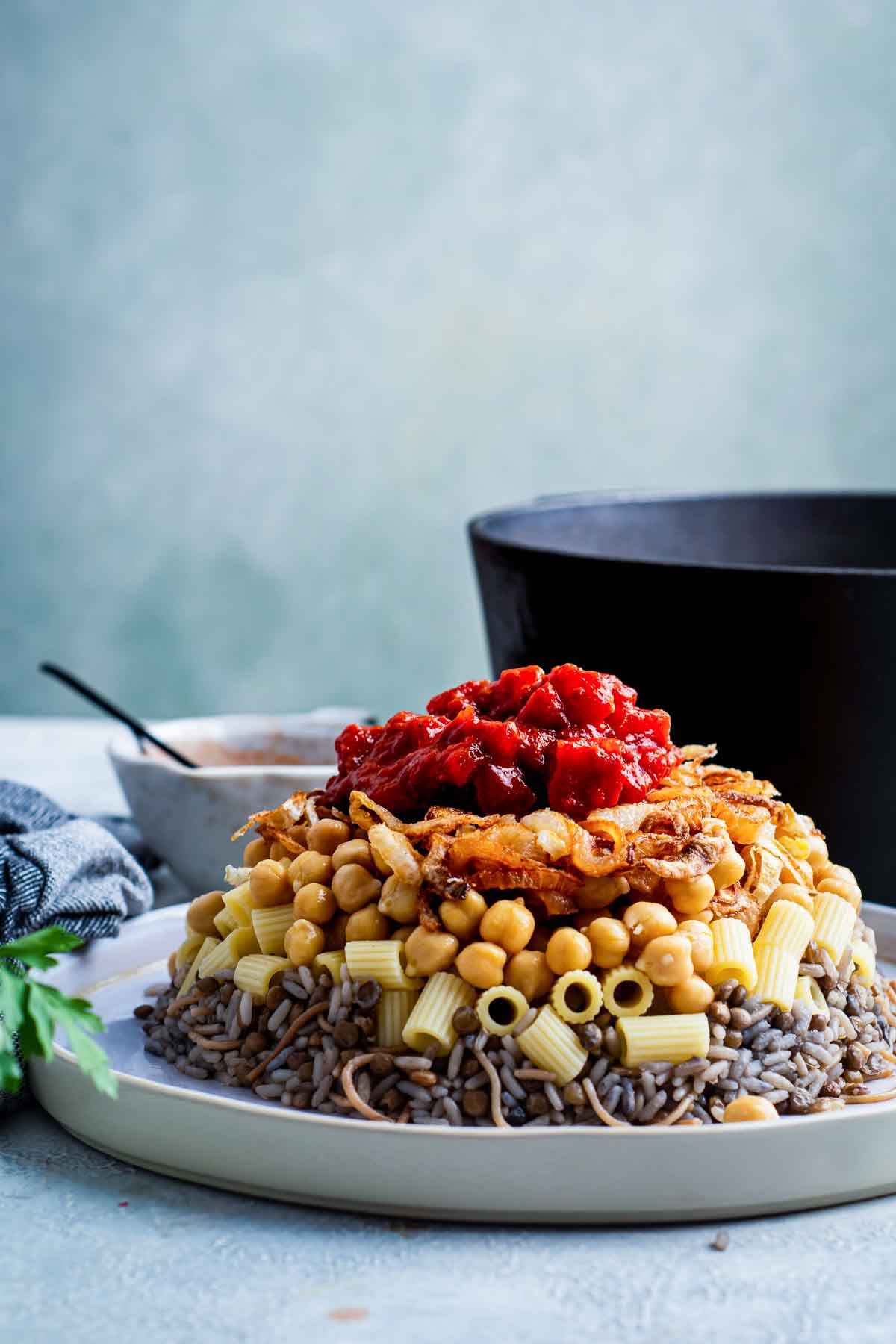
What to serve with koshari
While koshari is a full meal by itself, it is occasionally served with additional toppings or a few sides. Additional toppings can include garlic, vinegar, lemon juice, and cumin. It is often garnished with chickpeas, crispy fried onions, and parsley.
Typical sides include salads, pickled vegetables, or yogurt. Some people may also serve it with a spicy chili sauce or hot sauce on the side. (I’ve used sriracha to add a separate flavor element too…yes, I use sriracha for everything.) You can also serve it alongside Lebanese toum for a delicious garlicky pairing!
More Middle-Eastern Recipes
If you like Egyptian Koshary, here are some other recipes you’re sure to enjoy:
Helpful tools
The link below is an affiliate link. This means that if you choose to purchase using it, I will receive a small commission (at no additional cost to you). These small commissions help keep Chocolates & Chai going. Thank you.
A clear bowl is perfect for assembling your koshari. It allows you to show off the different layers!
And that’s it for today, bestie. Now, it’s your turn. Have you tried this Koshari recipe yet? Would you like to? Let me know in the comments below.
Don’t forget to follow me on Facebook, Pinterest, Instagram, YouTube and Twitter for all the latest. Or just sign up to be a part of my mailing list to have updates delivered straight to your inbox!
Print
How to make Egyptian Koshari (Koshary)
- Total Time: 1 hour 5 minutes
- Yield: 1 big bowl of koshari 1x
- Diet: Vegetarian
Description
Egypt’s National Dish! Learn how to prepare an authentic Egyptian Koshari (Koshary) using this step-by-step recipe.
Ingredients
- 16 oz canned chickpeas rinsed and drained
- 12 oz ditalini pasta, cooked according to package instructions
Fried Onions
- 3 large onions, sliced thin into rings
- 3 tsp salt
- 1 ½ tbsp cornstarch
- Vegetable oil, for frying
- Tomato Sauce
- 2 tbsp fried onions
- 1 tbsp reserved vegetable oil
- 7 cloves garlic, crushed
- 6 oz tomato paste
- 15 oz tomato sauce
- 3 cups water
- salt and pepper. to taste
- 3 tbsp white vinegar
- 1 tsp paprika
Lentil Rice
- 2 tbsp reserved oil
- ⅓ cup fried onions
- 2 cups brown lentils, rinsed and drained
- 2 cups rice, rinsed and drained
- 1 cup vermicelli, toasted
- 4 cups water
- 2 cups hot water
- 1 tsp ground cumin
Cumin Sauce (Dukka)
- 3 tbsp white vinegar
- 5 cloves garlic, crushed
- ½ cup hot water
- 1 tsp ground cumin
- Salt, to taste
- ½ tsp ground black pepper
- ¼ tsp paprika
Instructions
Fried Onions
- Toss the sliced onions with the salt and cornstarch.
- Add vegetable oil to a large deep pan over medium-high heat (the amount of oil you use will depend on the size of your pan – you want enough oil to cover the bottom of the pan by 1-inch so as to submerge your onions completely). Add in the tossed onion slices, and stir occasionally until the onions become golden-brown, approximately 12 minutes.
- Remove the fried onions, and set aside (as a single layer) to drain on a paper towel.
- Set aside the used oil (don’t throw it away!).
Tomato Sauce
- In a saucepan over medium heat add the reserved oil, and garlic. Cook, stirring occasionally, until fragrant, approximately 2 minutes. Be careful not to overcook – burnt garlic is not very tasty!
- Add the remaining ingredients. Bring to a boil, reduce heat to medium-low and cover, let simmer for 15 minutes.
Lentil Rice
- In a heavy pot over medium-high heat, add reserved oil with the fried onions, lentils, and a tablespoon of salt. Stir for 1-2 minutes. Add 4 cups of water and bring to a boil. Keep heat on medium high, maintaining a gentle boil for 10-15 minutes, or until the lentils are cooked through. Do not drain.
- Stir in rice, vermicelli, hot water, an additional tablespoon of salt and ground cumin. Bring to a boil, cover and reduce heat to low for 12-15 minutes, or until pasta is cooked. Fluff with a fork or light spatula.
Cumin Sauce
- Mix all the ingredients until fully combined.
Koshari Assembly
A great koshari is as much about its assembly as it is each individual component. Add the rice with lentil mixture as the base, top with the cooked ditalini pasta, prepared chickpeas, and fried onions. Drizzle on the tomato sauce and finally, the cumin sauce. Enjoy!
Notes
- Ditalini pasta is traditionally used, but I’ve seen koshari made using penne as well (I don’t think it looks as good, and it doesn’t scoop as well but it is possible). Cook the pasta al dente, per the package instructions.
- For the rice, a short grain rice is ideal.
- When cooking the rice, it’s best to use a heavy-bottomed pot, or an enamelled Dutch oven.
How to toast vermicelli
In a medium non-stick pan, heat a tablespoon of olive oil on medium. Add in the vermicelli and stir it continuously to ensure it browns evenly. Don’t leave it for too long, and make sure to stir constantly as vermicelli can burn quite easily!
- Prep Time: 10 minutes
- Cook Time: 55 minutes
- Category: Main Course
- Method: Cooking
- Cuisine: Egyptian

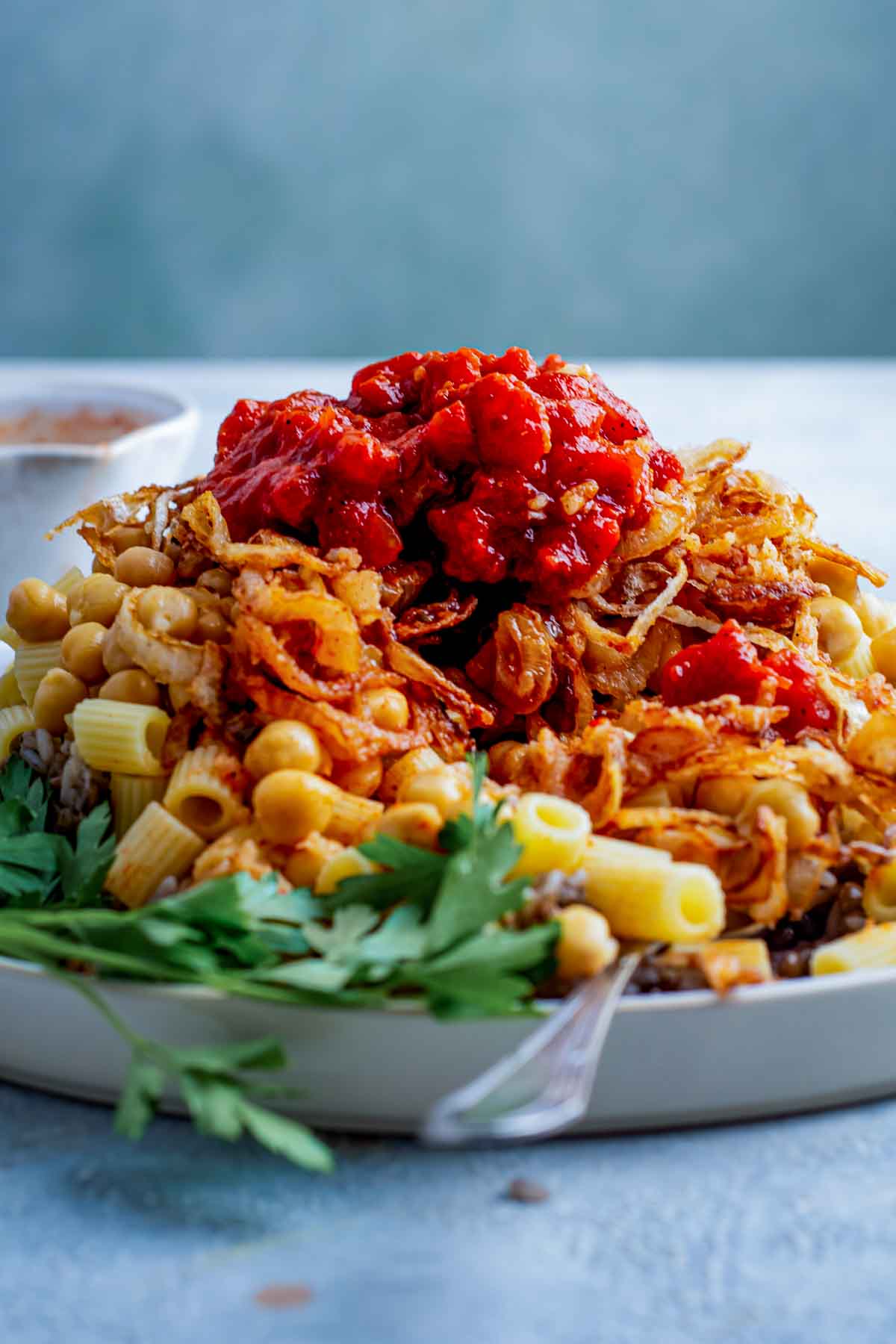
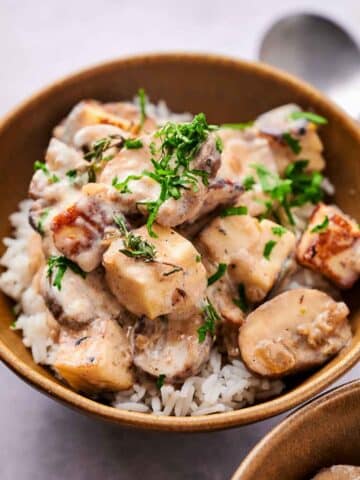
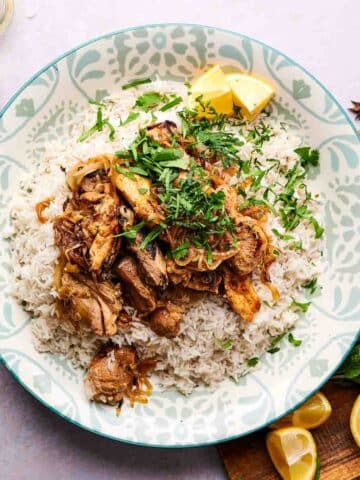
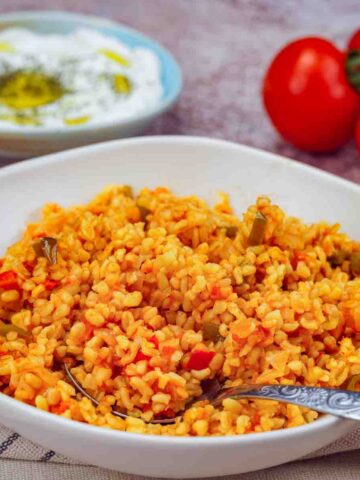
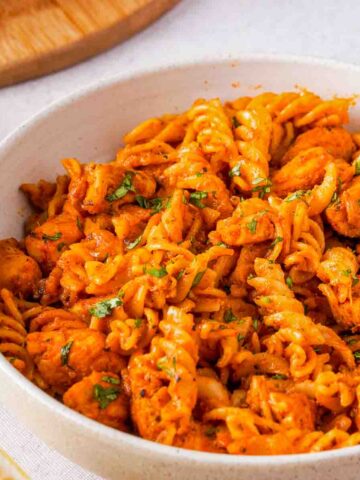


Aileen
I’ve never heard of this. But then I don’t know anything about Egyptian food. This sounds fantastic though! Give me all the carbs lol. I’m saving this to try it. Thanks Riz!
Riz
I hope you enjoy it, Aileen! The Egyptians are masters of comfort food! (They do yummy desserts too!)
Aileen
Riz, I meant to ask is the vermicelli cooked before you toast it? Sorry if that’s a dumb question. It’s a type of pasta isn’t it?
Riz
Hi Aileen,
There are no dumb questions! No, the vermicelli is toasted in the oil, and then cooked with the rest of the dish. It seems a little counterintuitive, but that’s how it’s done. (Technically, koshari and most Middle Eastern recipes use a type of vermicelli that is specific to the region (reshteh is an example that’s found easier in the West and Middle Eastern stores), but it’s not tooooo different from regular supermarket vermicelli (if your vermicelli is very long, you can consider breaking them in half or thirds to more closely resemble the Middle Eastern versions).
Hope that helps!
Reem
This is my favorite dish of all time! Yes, making it is time-consuming, but oh so rewarding. I can eat koshari all day, everyday! Thank you for this wonderful recipe!
Riz
Thank YOU for this wonderful comment!
Alina
Very good koshary recipe. We made yesterday.
Basim ElH
Delicious koshari recipe! We have made many versions since coming to the US and this one is our favorite!